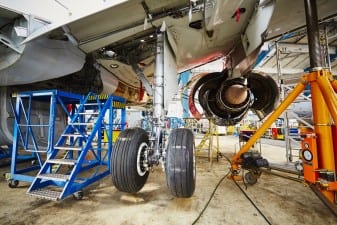Canadian Aerospace Manufacturing: Be Prepared for these Top Trends

Canada’s aerospace industry has been strong for decades, but new trends are transforming the industry and requiring aerospace manufacturers to be more proactive in their approach to growth. In 2015, Canada’s aerospace industry generated nearly $30 billion in revenues, of which 70% came from manufacturing – this marks an 11% increase between 2010 and 2015. Furthermore, a stunning 80% of revenues are generated through exports; these profits are mainly generated by American-based companies procuring parts.
As identified through ‘A Jetstream of Trends’, an aerospace manufacturing report published by Canadian Metalworking, Canadian manufacturers have enjoyed competitive advantages over international competitors, but these advantages are slowly slipping away. Its conclusion is that to maintain innovation and increase productivity, manufacturers need to develop/adopt advanced technologies and processes.
Fortunately for Canadian aerospace manufacturers, government grants and loans are available to reduce the cost of investments. Research and development to advance the aerospace industry, as well as technology adoption and employee training can all provide ways to build a company’s strengths while reducing costs.
Top Trends Impacting Canada’s Aerospace Manufacturing Industry
Aerospace manufacturing, and all manufacturing sectors for that matter, are being transformed at a blistering pace due to advancing technologies. More than ever before, manufacturers need to be at the leading edge of innovation to fulfill customer requirements. This revolution is causing some manufacturers to be displaced, however, those who are willing to keep up with the change are witnessing profits grow faster than ever.
Technology trends will continue to influence the Canadian aerospace industry for years to come. Here’s what to focus on to ensure your business doesn’t get left behind:
Lightweight Manufacturing Materials
Vehicle lightweighting is widespread among the automotive industry because consumers are demanding greater fuel efficiency. The aerospace industry is no different; with companies requiring lighter and more fuel-efficient aircraft, materials used during construction must be adapted.
Composite materials used during the manufacturing process are becoming increasingly popular. High-temperature alloys (such as titanium) and stainless steels are becoming the primary input material for many manufacturers, who have also needed to adopt innovative technologies to process it. Despite the cost, being able to satisfy market demand has significantly greater benefits and provides significant return to manufacturers.
Automated Manufacturing Processes
Reducing human labour in lieu of machining products doesn’t just cut costs, it can also help reduce variability and waste associated with rework. Aerospace manufacturing has become so advanced that much of the work needs to be done with highly-advanced machinery. If left to human cutting or welding, defect rates increase and customers may become less satisfied with the product/process.
Automating this process through advanced manufacturing equipment will help reduce cost and improve quality. Now more than ever, manufacturers are relying on technologies such as 5-axis CNC machines that can perform multiple processes without changeover or human intervention of any kind. This improves manufacturing speed, reduces variability, and leads to higher profitability in almost all cases.
Unmanned Aerial Vehicles (UAVs)
Although there are other applications for unmanned aerial vehicle technologies, UAVs are mainly purchased by governments and used to provide surveillance/ gather intelligence. As the capabilities of this technology improves, there will be a greater need to manufacture UAVs and deploy them more widely.
Manufacturers should note this trend and become a leader in the development of UAV technologies. Performing research and development projects has a wealth of benefits, from improving the skills and abilities of employees to commercializing new innovations. Few aerospace manufacturers devote significant capital towards R&D projects; this is a missed opportunity for many who could be leading the way and establishing new competitive advantages.
Canadian Government Funding for Aerospace Manufacturing Projects
While all the trends noted above provide aerospace manufacturers with new growth opportunities, none can be achieved without business investment. Manufacturers must be willing to invest in their materials, equipment, and employees to fully adapt to these industry changes.
Most aerospace manufacturers could use financial support to facilitate these profitability-boosting projects; therefore, government grants and loans may be used to offset a portion of project costs. When used intelligently, government funding can greatly extend cash flow and provide a vastly improved project return-on-investment (ROI).
Aerospace business executives should consider applying for Canadian government funding whenever large-scale projects are being planned. This can help retain tens of thousands, or even millions of dollars depending on the size and scope of the project.
How to Access Aerospace Funding Programs
Most government grants and loans for the Canadian aerospace industry can be accessed year-round, however, other programs require applications to be submitted by firm deadline date. Understanding the timelines for your upcoming project and matching them to the timelines of government funding programs is often the most challenging and time-intensive part of this process.
Aerospace manufacturers may learn about funding timelines and other pertinent funding details by registering for a free Canadian government funding webinar.
Recent Canadian Aerospace Manufacturing News:
- Firan Technology Group Corporation Receives Over $7M to Improve Canada’s Aerospace Industry
- Aerospace Regional Recovery Initiative: $250M to Support Canada’s Aerospace Sector
- Two Government Funding Programs Supporting Canada’s Regional Aviation Sector
- MDA LaunchPad: Technology Development Collaboration Opportunity
- $13M in Innovation Funding for the Canadian Aerospace Industry

